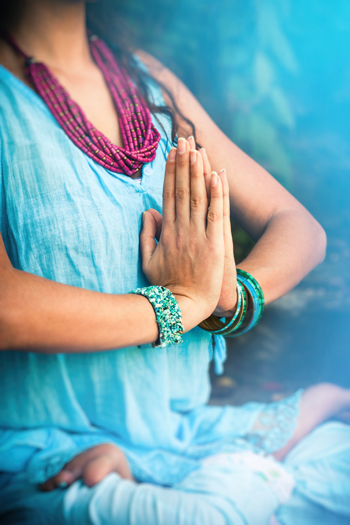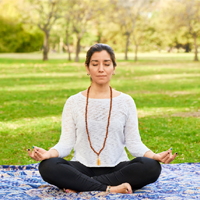Yoga for Stress

Yoga has been practiced for nearly 5000 years mainly in India but in last few decades it has gained popularity throughout the world as people have discovered the many health benefits of yoga. Yoga which is derived from the word “Yoke” means to bring together the mind, body and spirit. Since the practice of yoga affects both the body and the mind it helps one both physically and mentally. It helps achieve peacefulness of the body and the mind, helping one relax completely. We can easily see the physical benefits from yoga but its practice can also give one psychological benefits, such as stress reduction and a sense of well-being.
A person is said to be under stress when they are overloaded and find it hard to cope with the pressure. In the current fast paced world everyone from a child to an adult is affected by stress. Some people can work under pressure where as others cannot function under any kind of stress. As a result of the pressure and stress that one is under every day, it affects their mental peace, makes them agitated, angry and leads to many emotional and health problems. Some of the physical symptoms that people see when faced with chronic stress and an over activated nervous system are chronic headaches, depression, heart diseases, obesity, etc. According to the doctors most of the health issues these days are stress related. The worries and tensions of the modern day life deplete our energy level which is drawn from the main store house of the body – the nerve cells.
For most people relaxation means sleeping extra or zoning out in the front of the TV after a long day of work. Unfortunately this does not help reduce the damaging effects of stress on the body and mind. To effectively reduce stress the body’s natural relaxation response has to be activated. Yogic science believes that the nerves control the unconscious mind, and that when the nervous system is strong, a person faces stressful situations more positively. Yoga postures (asanas), meditation and controlled breathing are the popular means of stress management. With its quiet, precise movements and concentration required in the proper inhalation and exhalation during the practice of asanas, yoga draws your focus away from your busy, chaotic day and calms you mind and body as you move your body through poses that require balance and concentration.

Calming the mind: Our minds are constantly busy and active with various thoughts. Thoughts about the past, present and different scenarios for the future that are racing though our minds make it stressful and tiring. Yoga’s breathing technique done during the practice of Pranayama and also during asanas help in slowing down the thoughts and calming the mind. During breathing in yoga, one has to focus on each inhalation and exhalation thus excluding the thoughts. Each breath is tied to the present moment and not to the past or the future. Focusing on the present and on the breath prevents thoughts from your mind. This in turn calms it and removes stress as one is not thinking of the troubles of the past or the future. The asanas or poses in yoga are so physical and have to be done with such concentration, that all other thoughts and worries are put to the side, giving your brain a much-needed break.
Meditation: Meditation is the method of steadying, calming and opening the mind for the purpose of altering the states of consciousness. Meditation affects the body in exactly the opposite ways that stress does. Meditation restores the body to a calm state, helping the body to repair itself and prevents any further damage due to the many effects of stress. Simply spending ten or fifteen minutes on meditation can help one overcome stress and find some inner peace and balance. Meditation can also help us to understand our own mind. A calm mind gets rid of unnecessary and negative thoughts that cause agitation thus making one more peaceful and happy.
To meditate find a quiet place where you can sit undisturbed. Meditation has to be done daily in order to be effective. It is good to meditate in the morning and preferably at the same time every day. Sit in a comfortable posture like in Sukhasana or Siddasana. The most famous posture for meditation is Padmasana or the Lotus pose, but since this is a hard posture it is better to sit in a simple posture where the body is firm but at ease. Breathe quietly through the nostrils.
An object or a subject to meditate upon should be first chosen. Then sitting in a comfortable posture begin meditating by focusing on the chosen object or subject. Every time the mind wanders away, it needs to be reined in and get it to concentrate on the subject.
Unlike other stress relief therapies, meditation does not have any side effects. It is free and can be performed by any one – healthy, old and people with physical disabilities. Though meditation is not easy as it is very hard to control and tame the mind. But through constant, everyday practice it is possible to conquer and calm the mind as it has been done by many Yogis.
Pranayama: When the mind is agitated, a person’s breathing tends to be fast and shallow in turn agitating the nervous system. During the practice of pranayama, breathing is slow, controlled and each inhalation and exhalation is steady and deep. This slow and steady breathing calms the mind, body and spirit.
All the different kinds of Pranayama like Kapalbhati, Bhatrika, Ujayii, etc steady one’s breathing. Alternate Nostril Breath or the Anulom Vilom Pranayam is the most effective of all the pranayama’s in relaxing and calming the mind and body. In this pranayama air is slowly inhaled through one nostril while blocking the other nostril and exhaled out from the other nostril. After each inhalation the breath is held for a few seconds before being exhaled. This slow and deep breathing helps one get rid of all the tension and carries fresh oxygen thought the body.
 Asanas: The purpose of practicing asanas is to create a free flow of “prana”, energy though out our system in order to improve its functioning. During the performance of an asana the mind is focused on perfecting the posture and on inhaling and exhaling correctly. The deep breathing and focusing on the postures helps one forget their worries and tensions. Also in between asanas it is necessary to rest for a few seconds. During this resting period abdominal tension is released from your body, promoting deep breathing and subsequent relaxation. All the asanas help in relaxing the mind and relieving stress but the most important asana for relaxation is Savasana or the Corpse pose.
Asanas: The purpose of practicing asanas is to create a free flow of “prana”, energy though out our system in order to improve its functioning. During the performance of an asana the mind is focused on perfecting the posture and on inhaling and exhaling correctly. The deep breathing and focusing on the postures helps one forget their worries and tensions. Also in between asanas it is necessary to rest for a few seconds. During this resting period abdominal tension is released from your body, promoting deep breathing and subsequent relaxation. All the asanas help in relaxing the mind and relieving stress but the most important asana for relaxation is Savasana or the Corpse pose.
To perform Savasana lie down flat on your back, heels a little apart with the feet limp and facing outwards. The arms should lie alongside the body, palms facing upwards and resting on the floor. Breathing should be through the nostrils and not through the mouth. Just observe the breathing, after a while it will become quiet and of even rhythm. Next focus on every part of your body from the feet to the scalp, looking for tension and letting it go. This process of letting go of the tension from every part of the body will help in relaxing the body completely. It removes fatigue and gives rest to the mind. Savasana must be practiced at the end of every yoga session. It is a cooling down asana. It cools and rests not only the body but also calms the mind.
As we have seen from the above three yoga techniques, it is possible through practice and patience, to get rid of stress, calm the mind and as a result live a happy and peaceful life. Yoga has many pros like positive reinforcement through stress reduction, relieves physical aches and pains. The only cons are that it requires patience and has to be practiced often to see the effects. Though all the asanas cannot be performed by people with ailments, meditation and some of the pranayamas can be performed by all.































